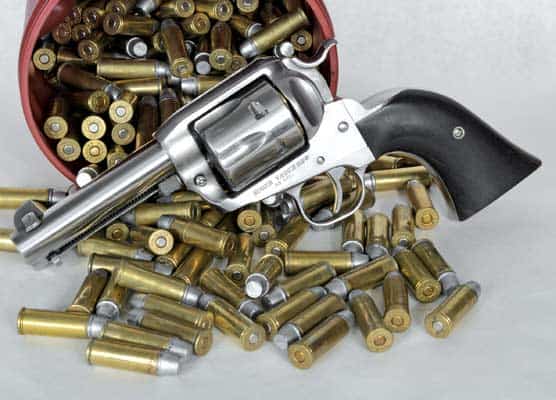Ayoob Files: Vengeance or Self-Defense? The Inez Garcia Case
Situation: A ripple of gunfire triggers a series of trials in which many critical issues are raised.
Lesson: The pursuit of criminals has a high likelihood of ending poorly. Straight-up self-defense trumps “impaired capability” defenses at trial. Remaining calm is a courtroom imperative.
It is March 19, 1974, at 9:37 p.m. on Monterey Street in Soledad, Calif. The eyes of witnesses are drawn to three people. Two of them, Hispanic males, will later be described as a “Mutt and Jeff” team. One is short and wiry, while the other weighs more than 300 lbs. The third person is a Latina and what catches the witnesses’ attention is the rifle she is holding.
The witnesses see a large knife in the big man’s hand and a flash of movement. Immediately, there is a crackle of gunfire. Sharp reports pierce the night as eight spent .22 LR cases sprinkle the pavement. The big man, Miguel Jimenez, falls heavily to the ground. The smaller man, Luis Castillo, runs. Witnesses see the woman point the rifle at him, but she does not fire. Then she lowers the gun and walks away.
The woman’s name is Inez Garcia. She has triggered not only a .22 caliber rifle but a case that will arouse controversy — and trial tactics debate — that will last for decades and still be under discussion long after she and the attorneys who represented her are gone.
Prelude
Inez Garcia was 30 years old at the time of the shooting and had led a hard life. Born with some cognitive challenges, she showed up well below average on intelligence tests. She never learned to read or write in either English or Spanish or tell time.
At the time of the incident, she was married with an 11-year-old son. Her Cuban-born husband was in prison for crimes related to his militant anti-Castro activities. In her younger years, she experienced behavior issues and had been institutionalized. Working in menial jobs, Inez was at or below the poverty line and currently living with her son at the home of Alfredo Medrano, who was afflicted with tuberculosis. Virtually all who knew her at the shooting described her as a nice, religious lady, always eager to be helpful to anyone.
On the night in question, their home had hosted Jimenez and Castillo. Both men had been drinking beer and brandy, and it was alleged there had been drug use as well, but Garcia had merely sipped a small amount of whiskey. The night had turned ugly, and both men had brutally beaten Mr. Medrano over a perceived slight. In the course of the discussion, they mentioned a man Castillo had stabbed in an earlier incident. They began to turn both hostility and sexual innuendo upon Inez Garcia.
Assault
Not long after, Garcia swore, the pair caught her alone. Garcia said the big man had stood by menacingly, armed with a long kitchen knife, as the smaller man raped her. She said she was forced to take off her clothes to facilitate the attack for fear of being killed.
Garcia would say she returned to the home she platonically shared with Medrano and there received a call from Castillo and Jimenez in which they threatened her with death if she told anyone of the rape. There were two firearms in the apartment, and she found ammunition to load them both: a Remington 870 Wingmaster 12-gauge pump shotgun and a .22 caliber semi-automatic rifle. (1). Her roommate Medrano, also fearing death at the hands of Jimenez and Castillo, took the shotgun. They left the place together in Medrano’s car. Shortly after that, they spotted the violent pair in the street.
Street Justice Or Self-Defense?
And now, Jimenez was dead. The forensic pathologist who did the autopsy would testify at trial, “(T)here were two abdominal wounds which I interpreted as being gunshot wounds; One on the right side of the abdomen and one on the left side of the abdomen entry and exit wound, and they were very superficial just through the fatty tissue. And there was an abrasion of the right thigh in the front, which I also interpreted as possibly being a grazing type of wound from a bullet.” (2)
These were adynamic injuries, that is, neither neutralizing nor life-threatening. What had killed him was one more bullet. This one, weighing 40 grains, had entered the left eye and pierced the brain. At more than 300 lbs., Jimenez’s body weighed well over two million grains. The bullet that felled him seemed to exemplify the David versus Goliath disparity between the knife-armed man and the rifle-armed woman.
Nonetheless, she was indicted for murder. The case immediately became a cause célèbre followed nationwide, with the rare distinction of rallying both sides of the political spectrum to Garcia’s side. On the farthest right, anyone who thought the movie Death Wish should be a training film could see “street justice” in the prosecution’s narrative of a woman hunting down and killing those who raped her. In both the center and left, the Inez Garcia case plucked a chord in the burgeoning Women’s Rights and Women’s Liberation movements.
The First Trial
A lot was going against Inez Garcia at trial. She had left the shooting scene, meekly surrendering shortly after that, so there was a “flight equals guilt” element. The prosecution saw her having left home armed as making her the aggressor seeking revenge. Like many sexual assault victims, she had failed to mention the rape initially, giving rise to the suspicion she had made it up, and that was buttressed when the prosecution introduced testimony she’d torn her blouse and had someone punch her in the face so she’d have a bruise to show if she claimed self-defense.
Garcia’s lead defense counsel was Charles Garry, an avowed Communist and counsel for the Black Panther Party and Jim Jones’ Peoples’ Temple. He chose to go with an impaired capability defense, hoping to establish his client had been so traumatized by the rape she didn’t know what she was doing when she killed Jimenez. One expert witness he called for the defense was Dr. Jane Oldden, a professor of psychiatry.
Dr. Oldden told the jury in part, “She was in a state of impaired consciousness, which is what I meant by so-called dissociative act. After the rape and in the whole subsequent events until she fired, she was indeed engaged in the internal conflict between the feeling that she was demeaned and defiled and permanently damaged by the rape so that she was not thinking about the consequences in the sense of the world around her or what the world around her would judge the consequences of her act, and she was in an impaired consciousness. To explain this better, would-be dissociative acts are like sleepwalking …” (3)
Garcia hurt her own case during the trial. In his informative book The Trial of Inez Garcia, Kenneth W. Salter wrote the jury was present in the courtroom when at one point, Inez stood up from the defense table and shouted at the judge, “Why don’t you find me guilty and put me in jail? I killed the motherfucker because I was raped, and I’ll kill him again. You’re acting like an old — you pig!” (4)
On the opposite side of the case was a young and very professional assistant district attorney, Arthur “Skip” Braudrick. In reviewing the transcript, one gets the impression his heart might have been with the defendant, but his head was running the game, focusing on elements he felt constructed a solid case of murder. In his close, the prosecutor argued to the jury, “It is your job as jurors not to decide this case on sympathy or passion, but on the facts.” (5)
In the end, it was Skip Braudrick’s argument that prevailed. The jury found Inez Garcia guilty, and she was promptly incarcerated.
Appeal
In December 1975, the Court of Appeal found the judge’s instructions pertaining to proof beyond a reasonable doubt were defective. Her conviction was overturned, and the case was remanded for a second trial.
By then, the world was watching.
The Second Trial
Garcia’s second trial took place in 1977. This time her lead defense attorney was Susan B. Jordan. Jordan had taken part in the appeal and was intimately familiar with the trial testimony and, perhaps more important, the overriding issues. An activist lawyer, Jordan was also a pragmatist who clearly understood jury psychology and legal principles.
Where Mr. Garry had focused heavily on Garcia’s psychological burdens and an impaired capacity defense, Ms. Jordan went straight to the heart of the matter. She focused primarily on pure self-defense issues.
To establish self-defense, it must be shown the defendant was in immediate and unavoidable danger of death or great bodily harm. This, in turn, demands three elements must have been present, most commonly known as Ability, Opportunity and Jeopardy.
Ability means the power to kill or cripple: a weapon or disparity of force. Disparity of force means such an advantage in unarmed combat that the ability to harm or kill becomes the equivalent of a deadly weapon, warranting the intended victim’s recourse to an actual deadly weapon, such as a firearm. Opportunity means the opponent can immediately employ that power, i.e., within range of doing lethal or crippling harm. Jeopardy is the manifest intent element: The assailant must have manifested, by words and/or actions, an intent to kill or cause grave bodily injury.
Jordan built her case masterfully, brick by brick.
Ability was present three-fold. When Garcia began pulling the trigger, Miguel Jimenez was holding a large knife. He was also vastly bigger and stronger than she, over 300 lbs. He had another element of disparity of force on his side, the force of numbers: His partner in crime, Luis Castillo, was right there with him. The Ability box was checked.
Opportunity was present for either man to attack Inez Garcia. The testimony of eyewitness Alfredo Medrano was Jimenez was about 20 feet from Garcia when she opened fire. (6) Almost a decade later, the pioneering research by Dennis Tueller of the Salt Lake City Police Department would show the average adult male could close 21 feet and inflict a fatal stab wound in an average time of 1.5 seconds from a standing start. But even in the 1970s, it was obvious that a man 20 feet away with a knife could be an immediate deadly danger. Opportunity: Check.
Finally, Jimenez’s and Castillo’s previous actions had established manifest intent. The rape by Castillo, abetted by Jimenez’s threatening, looming presence, their savage beating of Medrano that Garcia had witnessed, and the phone call threatening her with death all made it clear Garcia was in potentially lethal danger from both of them at the time she opened fire.
Garcia had been behind bars for the entire time between trials. The second trial began on St. Valentine’s Day, February 14, 1977. On March 4, after 11 hours of deliberation, a jury of 10 men and two women returned a Not Guilty verdict on all counts.
The courtroom gallery exploded in cheers. Inez Garcia was a free woman again.
Follow-Up
Inez Garcia became an advocate for women’s rights in general and the rights of rape victims in particular. She passed away from cancer in 2003. Charles Garry died at age 82 in 1991, leaving behind an autobiography he titled Streetfighter in the Courtroom: the People’s Advocate. Susan Jordan’s stellar legal career ended in the fatal crash of a light plane in 2009.
And Luis Castillo, the man accused of raping Inez Garcia, was never even charged.
Lessons
From the trial tactics side, the stark lesson from this case is that a straightforward self-defense strategy beats an impaired capability defense. In his informative study of this trial, cited previously, Kenneth Salter wrote, “The strategy of the defense (in the first trial) was to premise Inez Garcia’s actions on a defense of diminished capacity: to argue to the jury through the use of expert psychiatric testimony that after the rape Inez was hysterical and didn’t know what she was doing. She was so emotionally upset that this woman with a prior history of mental instability was so affected by the rape that it thrust her into such a state of mental impairment that her hysteria and terror made her seek to kill in self-defense.” (7)
The trouble is, the impaired capability defense has a history of success that is spotty at best and often fails as it does here. The jury pool is made up of the general public. The general public tends to think, “Let my 11 new friends and me on the jury get this straight. For whatever reason, this person loses their mind and kills people, and you want us to put them back on the same streets as our loved ones? Um … No!”
There may also have been misogyny at work that went undetected during jury selection, and if so, an admission of “homicidal hysteria” is unlikely to win a Not Guilty vote. A male juror from the first trial was alleged to have later remarked, “A rapist is just trying to give a woman a good time,” or words to that effect.
As established by Susan Jordan in the second Garcia trial, straight-up self-defense is something virtually everyone in the jury pool can relate to. This is not to say there is no place for the so-called “battered women’s defense,” the proper term for which is Learned Helplessness, to explain why such a victim might not have gone directly to the police. It seems to work best when presented supplementally rather than as a cornerstone theory of the defense.
Now, lessons from the armed citizen side. First, win the race to the phone and report the crime committed against you. If Garcia had gotten to the phone and reported her rape at the hands of Castillo and Jimenez, they would probably have been quickly picked up, and there would have been no shooting at all. (The suspects hadn’t gone far. The shooting occurred some six blocks from the rape scene.)
The prosecution made a big deal of the vigilante justice thing. In the second defense, there was more emphasis on the death threats made to Garcia by the two men in the immediate aftermath of the rape. The jury saw the progression of violence. Castillo, and particularly Jimenez, had savagely beaten Medrano. The escalation then went to rape and then up into the death threats. These were sufficient to warrant someone arming themselves for personal protection. The jury learned that Jimenez had a blood alcohol content of 0.16% at the time of death, which today would constitute “twice the standard for legally drunk.” While the prosecution focused on its allegation of her “hunting them down,” the defense concentrated hard on the very seconds before the first shot, when Jimenez faced the defendant with an 8″ blade knife in his hand, at close enough distance to kill.
Unless one is still under attack by the original attacker’s accomplices, leaving the scene is never a good idea. “Flight equals guilt” is a precept so old you find it in the Bible. Proverbs 28:1 states, “The wicked flee where no man pursueth, but the righteous man stands his ground as bold as a lion.” In this case, that “consciousness of guilt” element further steepened the already steep hill the defense team was facing.
Don’t babble. There was testimony that right after the rape, Garcia had blurted she wanted to kill her attackers. That goes to intent and state of mind issues. It hurt her case. There was testimony that, between the shooting and the arrest, she had said she “shot the deceased five times in the heart with one more bullet in the face.” That didn’t help either.
Resist the instinct to pursue. As in this case, you may be seen not as the victim with a right to fight back but the vindictive, murderous instigator of a second encounter.
It is true “perfect can be the enemy of good.” The state alleged Garcia made someone punch her in the face and tore her blouse to create a stronger image of herself as a victim and introduced testimony to that effect. The defense denied it. Whichever is true, trying to look more like a victim — or in any other way trying to make your case look better than it is, altering or planting or destroying evidence — is absolute poison that can kill a legitimate self-protection case in court.
My old friend John Farnam’s advice applies to this case: Never go to stupid places and do stupid things with stupid people. If Jimenez and Castillo hadn’t been accepted in Garcia and Medrano’s abode while they were drinking, none of this would have happened, and you would be reading about a historic shootout or something on this page instead of the very instructive case of Inez Garcia.
Footnotes: (1) There is no reference to the make and model of the .22 in the trial transcript reviewed. (2) Dr. Konrad Wolfgang Titus’ testimony in the first trial. (3) The testimony of Dr. Jane Oldden in the first trial. (4) Salter, Kenneth W., The Trial of Inez Garcia, Berkeley, CA: Justa Publications, 1976, page 182. (5) Salter, Ibid., page 310. (6) From the taped 3/20/74 interview of Alfredo Medrano by District Attorney’s Office Investigator Robert S. Russell. (7) Salter, op. cit., page iv.




